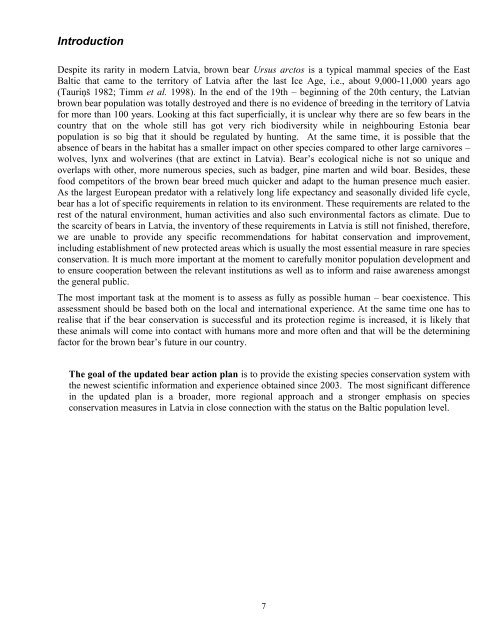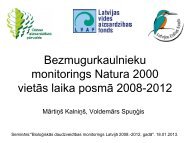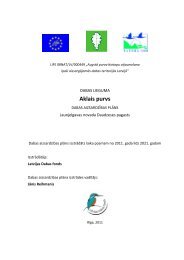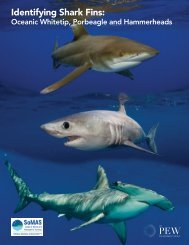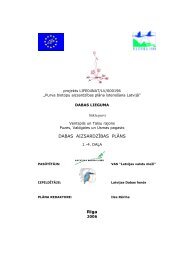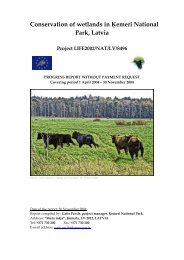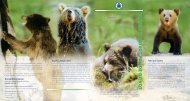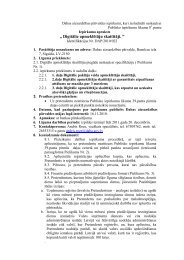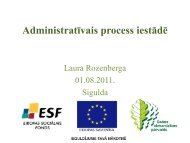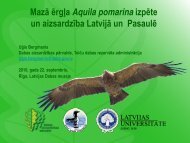Brown bear Ursus arctos - Dabas aizsardzības pārvalde
Brown bear Ursus arctos - Dabas aizsardzības pārvalde
Brown bear Ursus arctos - Dabas aizsardzības pārvalde
You also want an ePaper? Increase the reach of your titles
YUMPU automatically turns print PDFs into web optimized ePapers that Google loves.
Introduction<br />
Despite its rarity in modern Latvia, brown <strong>bear</strong> <strong>Ursus</strong> <strong>arctos</strong> is a typical mammal species of the East<br />
Baltic that came to the territory of Latvia after the last Ice Age, i.e., about 9,000-11,000 years ago<br />
(Tauriņš 1982; Timm et al. 1998). In the end of the 19th – beginning of the 20th century, the Latvian<br />
brown <strong>bear</strong> population was totally destroyed and there is no evidence of breeding in the territory of Latvia<br />
for more than 100 years. Looking at this fact superficially, it is unclear why there are so few <strong>bear</strong>s in the<br />
country that on the whole still has got very rich biodiversity while in neighbouring Estonia <strong>bear</strong><br />
population is so big that it should be regulated by hunting. At the same time, it is possible that the<br />
absence of <strong>bear</strong>s in the habitat has a smaller impact on other species compared to other large carnivores –<br />
wolves, lynx and wolverines (that are extinct in Latvia). Bear’s ecological niche is not so unique and<br />
overlaps with other, more numerous species, such as badger, pine marten and wild boar. Besides, these<br />
food competitors of the brown <strong>bear</strong> breed much quicker and adapt to the human presence much easier.<br />
As the largest European predator with a relatively long life expectancy and seasonally divided life cycle,<br />
<strong>bear</strong> has a lot of specific requirements in relation to its environment. These requirements are related to the<br />
rest of the natural environment, human activities and also such environmental factors as climate. Due to<br />
the scarcity of <strong>bear</strong>s in Latvia, the inventory of these requirements in Latvia is still not finished, therefore,<br />
we are unable to provide any specific recommendations for habitat conservation and improvement,<br />
including establishment of new protected areas which is usually the most essential measure in rare species<br />
conservation. It is much more important at the moment to carefully monitor population development and<br />
to ensure cooperation between the relevant institutions as well as to inform and raise awareness amongst<br />
the general public.<br />
The most important task at the moment is to assess as fully as possible human – <strong>bear</strong> coexistence. This<br />
assessment should be based both on the local and international experience. At the same time one has to<br />
realise that if the <strong>bear</strong> conservation is successful and its protection regime is increased, it is likely that<br />
these animals will come into contact with humans more and more often and that will be the determining<br />
factor for the brown <strong>bear</strong>’s future in our country.<br />
The goal of the updated <strong>bear</strong> action plan is to provide the existing species conservation system with<br />
the newest scientific information and experience obtained since 2003. The most significant difference<br />
in the updated plan is a broader, more regional approach and a stronger emphasis on species<br />
conservation measures in Latvia in close connection with the status on the Baltic population level.<br />
7


